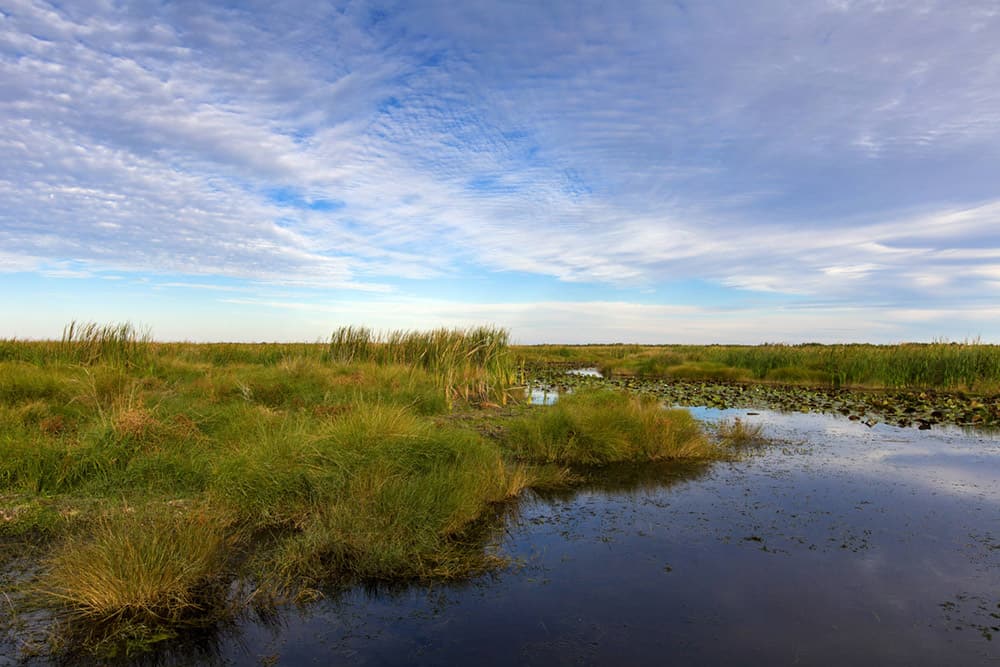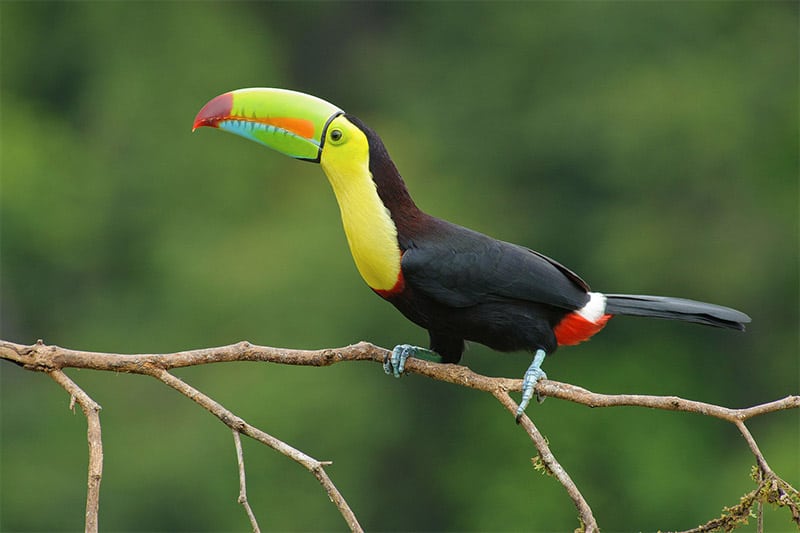Iowa is the gift of glaciers. Glaciers gave Iowa the matrix for its rolling prairie. Melting glaciers shaped its river beds and left the depressions that became its lakes and marshes. The Loess Hills that line the western edge of the state came from rocks that glaciers ground into dust. Melt water from glaciers carved the steep bluffs that characterize the rugged scenery of northeastern forests.
During the last two million years, glaciers have advanced repeatedly across North America from the north, blanketing what is now Iowa with rocks, sand, silt, and clay hundreds of feet deep. Trees and grasses drove their roots into this glacial material and built some of the deepest, most fertile soil in the world. As the region dried after the last Ice Age, forests shrank and grasses predominated, creating a vast expanse of prairie—a sea of grass. Flowers, insects, and larger animals found niches in the prairie, along with an abundance of birds, including Swainson’s hawks and ground nesters such as northern harriers, upland sandpipers, greater prairie-chickens, short-eared owls, bobolinks, and meadowlarks. Today, despite the immense changes that agriculture has brought to the land, meadowlarks still sing from fence posts where the prairie once reigned, and many other prairie bird species still return every year to Iowa pastures and fallow fields.
Iowa has glaciers to thank for its abundance of wetland birds, too. About 15,000 years ago, the extension of a glacier reached down from Minnesota into the middle of Iowa, as far south as Des Moines. Geologists refer to the land that the glacier covered as the Des Moines Lobe. The glacier persisted in Iowa for about 3,000 years. When it melted, it left a flattened landscape dimpled with lakes and shallow depressions called prairie potholes. Canada geese and many species of ducks flourish in the prairie potholes, along with grebes, herons, bitterns, black terns, yellow-headed blackbirds, marsh wrens, and swamp sparrows. Although 95% of Iowa’s wetlands have been drained and put into cropland, the remnants still provide major nesting habitat for water-dependent species and rest stops for birds heading farther north.
Enormous volumes of glacial melt water carved the wide alluvial plains that form the valleys of the Mississippi and Missouri rivers. Although the Missouri River has now been channelized, its miles-wide floodplain serves as a migration corridor for raptors, waterfowl, and shorebirds. A million snow geese or more migrate along the Missouri River Valley each year.
The Mississippi River, which Mark Twain wrote about as a free river with a mind of its own, is now divided by a series of locks and dams into string of large pools that migrating waterfowl use as staging areas. The Mississippi River Valley is the most heavily traveled migratory flyway in North America. Many sites along the river offer excellent viewing for waterfowl, raptors, shorebirds, and woodland species. The Mississippi’s backwaters harbor breeding herons, soras, pileated woodpeckers, and prothonotary warblers, among many others.
The courses of Iowa’s other rivers were also set by melting glacial water. Nearly all of Iowa’s forests are found along rivers. Such woodlands are nesting grounds or migratory stopovers for whip-poor-wills, gray catbirds, tufted titmice, woodpeckers, and more than 30 species of warblers. Many of the state’s beautiful and bird-rich parks are found adjacent to rivers, including Ledges State Park, in Boone Coounty and Lacey-Keosauqua State Park, in Van Buren County, both along the Des Moines River.
BIRDING IN IOWA
Iowa enjoys a diverse collection of bird life, with 406 species of birds having been found in the state. Of these, 301 occur regularly, while another 101 are rare. Two (sharp-tailed grouse and Eskimo curlew) are extirpated in Iowa, and two (passenger pigeon and Carolina parakeet) are extinct.
Because Iowa lies between the two major migratory flyways of the Missouri River Valley and the Mississippi River Valley, birders have the opportunity to witness the passage of many species that do not nest in Iowa but that pass through the state in spring and fall. Furthermore, Iowa is a crossroads state. A number of southern birds spend the summer in Iowa, including yellow-throated and worm-eating warblers. Northern mockingbirds, common in southern states, regularly wander into Iowa. Summer tanagers, too, straggle north, breeding in the Loess Hills and along the Mississippi and Des Moines Rivers in the southern half of the state.
Birds of the eastern woodland forests, including Acadian flycatchers and pileated woodpeckers, regularly range west to Iowa. Western specialties that extend into Iowa include western kingbirds and spotted towhees, and occasionally Townsend’s solitaires and lark buntings. Winter visitors from the North include snowy owls, pine siskins, and other northern finches.
Iowa’s four main reservoirs get lots of attention from birders, because they attract a great diversity of birds, including rarities. The reservoirs are Saylorville Reservoir in Polk County, Red Rock Reservoir in Marion County, Coralville Reservoir in Johnson County, and Rathbun Reservoir in Appanoose County. Public lands that offer good birding include Iowa’s numerous state parks, state preserves, state forests, state public hunting areas, county parks, county natural areas, and city parks.
TIPS FOR SUCCESSFUL BIRDING IN IOWA
- Tune in to migration. Many species merely pass through Iowa on their way to somewhere else. For example, 22 of Iowa’s 36 regularly-occurring wood warblers can be found only during spring or fall, some only for a few weeks. Yet spotting them is the highlight of many Iowa birders’ year.
- Get help from Iowa’s passionate and widespread community of birders. They’re eager to share their interest with newcomers. Check out the Iowa Ornithologists’ Union (IOU), at http://www.iowabirds.org/iou/iou.asp on the Internet. You’ll find directions to good birding spots and information on Iowa birding clubs around the state, along with county checklists and photos of Iowa birds. You may wish to join an Iowa Christmas Bird Count, an annual event in which birders spend a day looking for and recording all the birds they can find in a circle of 15-mile diameter. Contact information about Christmas Bird Counts is on the IOU website.
- Get good maps. Iowa has many rural county roads, and gas station maps aren’t detailed enough. You need maps that show every road, distinguishing between gravel and dirt roads. TIP: if you continue driving past a sign that says “Gravel ends” in wet weather, you are likely to get stuck in clay that can mire a tractor. The Iowa Department of Transportation publishes detailed maps of each county. Another excellent reference is the DeLorme Iowa Atlas and Gazetteer, which shows all major and minor roads, lakes, rivers, parks, and topographical data in one convenient book. Iowa has 99 counties, lined up fairly neatly in nine rows. Instructions to birding locations usually include the name of the county, so it helps to keep a map of the counties handy.




